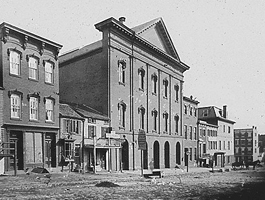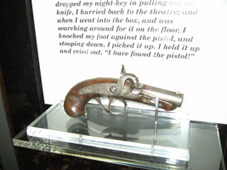 |
Ford's Theatre
Library of Congress |
This national historic site consists of two units: Ford's Theatre, the scene of one of the most tragic events in American history—the assassination of Abraham Lincoln, the 16th president of the United States; and the Petersen House, the house where Lincoln died. President Lincoln, on the verge of winning a bloody civil war to preserve the Union, was the first president to be assassinated. The news of Lincoln's death replaced northern euphoria at the war's end with grief and anger.
The Civil War began five weeks after Lincoln’s inauguration in March 1861, with the shelling of the Federal garrison at Fort Sumter by the newly formed Confederacy. Blending principles and political skill, Lincoln provided strong wartime leadership for the North and assumed unprecedented presidential power. One of his first tasks was keeping several border States from seceding. Some people denounced the measures he took to silence critics of the war and Confederate sympathizers as unconstitutional, but he took the position that the national emergency justified his actions. Until he finally found an effective general in Ulysses S. Grant, he often participated directly in military decision making. He and his secretary of state succeeded in preventing international recognition for the Confederacy. His primary war aim was always the preservation of the Union. His issuance of the Emancipation Proclamation on January 1, 1863, freeing the slaves in the Confederacy, and his support for the 13th Amendment to the United States Constitution, outlawing slavery, earned him the undying gratitude of African Americans.
The tragedy of the conflict weighed heavily on Lincoln as the war raged on and the lists of casualties grew. He won reelection to a second term in 1864, as Union army victories suggested that the war might be nearing its end. Lincoln was already seeking ways to reconcile the North and South. His Second Inaugural Address looked forward to a moderate Reconstruction program, guided by the principle of “malice toward none, with charity for all.” Lincoln did not live to put these policies into effect.
 |
The assassination of President Lincoln
Library of Congress
|
Confederate General Robert E. Lee surrendered to General Grant at Appomattox Courthouse on April 9, 1865, effectively ending four years of devastating warfare. President Lincoln proclaimed April 14 as a day of thanksgiving. To celebrate, he decided to attend a performance of a lighthearted comedy, Our American Cousin, at Ford’s Theatre.
In 1865, Ford's Theatre, an imposing brick building three stories high with five arched doorways at street level, was one of the finest and most modern in the nation. The management made elaborate preparations for the presidential visit. Stagehands created a large new box at the south side of the stage, decorated it with American flags, and furnished it with comfortable chairs. About 8:30pm, the presidential party arrived at the theatre. A full house greeted Lincoln with a standing ovation.
At approximately 10:15pm, John Wilkes Booth slipped silently through the unguarded door at the rear of the box and fired a derringer into the back of Lincoln's head at close range. One of Lincoln’s companions, Major Rathbone, grappled with the assassin, but Booth managed to break free. Booth vaulted over the box balustrade and managed to escape through the back entrance of the theatre. Stunned, the audience reacted slowly, but pandemonium followed with the dawning realization of what had happened. Doctors who had rushed to the presidential box ordered that Lincoln be carried to the nearest bed, which turned out to be in the back parlor of William Petersen’s boarding house, across the street.
 |
John Wilkes Booth's gun
In the Ford's Theatre basement museum |
Doctors watched over the dying president throughout the night. A continuous stream of Cabinet members, Congressmen, Army officers, and friends came to pay their respects at the bedside. Mary Todd Lincoln remained in the front parlor, distraught. Lincoln died early the next morning without regaining consciousness.
John Wilkes Booth was a member of a famous theatrical family. During the Civil War, his hatred of the North and fanatical commitment to the South became an obsession, and he hatched several plans to kidnap or assassinate Lincoln and members of his Cabinet. Lincoln’s assassination was part of a more complicated conspiracy, the only part that succeeded. Booth fled Washington, DC on horseback and headed for southern Maryland with David Herold, one of the conspirators. On April 26, 12 days after President Lincoln’s death, Union cavalry surrounded the tobacco shed in Port Royal, Virginia, where Booth and Herold were in hiding. When the troops set fire to the shed, Herold surrendered, but Booth held out. He died of a gunshot wound as the shed burned down around him.
After a highly irregular military trial, four of the conspirators were found guilty and hanged; the sentences for the other four ranged from six years hard labor to life in prison. President Andrew Johnson pardoned the surviving conspirators in 1869.
The War Department placed guards outside Ford’s Theatre after the assassination and cancelled all future productions. John T. Ford, the theatre's owner, planned to reopen it later in the year, but public opinion prevented him from doing so. In 1866, he sold the theatre to the Federal Government, which fireproofed it by removing the woodwork and converted it into an office building. For many years, the building housed the Army Medical Museum and the records and pension office of the War Department. Tragedy struck once again on June 9, 1893, when a section of the third floor collapsed, killing 22 people and injuring 65 others.
In 1933, the National Park Service took over Ford’s Theatre, which was by then the Lincoln Museum. The National Park Service rebuilt the interior of the theatre to approximate its appearance on the night of April 14, 1865. The reconstruction design used historic photographs, drawings, woodcuts, and contemporary accounts to achieve accuracy of interior furnishings and decorations. Since 1968, Ford’s Theatre has included a live working theatre. The National Park Service has administered the Petersen House, a substantial three-story brick row house built in 1849, since the 1930s. It was rehabilitated in the late 1950s.
| Plan your visit |
Ford's Theatre National Historic Site, a unit of the National Park System, is located at 511 10th St. NW, Washington, DC. The Petersen House is across the street at 516 10th St. NW. Click here for the National Register of Historic Places file: text and photos. Ford's Theatre National Historic Site is open for tours from 9am to 5pm. The Box Office is open from 8:30am to 5pm. In the event of evening performances, the Box Office will remain open until 8pm. In the event of an evening History on Foot walking tour, the Box Office will remain open until the tour begins. The Petersen House is open 9:30am to 5:30pm. Admission into the Ford's Theatre National Historic Site is free, but a ticket is required. For more information, visit the National Park Service Ford's Theatre National Historic Site website or call 202-426-6841.
Both Ford’s Theatre and the Petersen House have been documented by the National Park Service’s Historic American Buildings Survey. Ford's Theatre National Historic Site is also featured in the National Park Service Washington, DC Travel Itinerary. |
|
|

